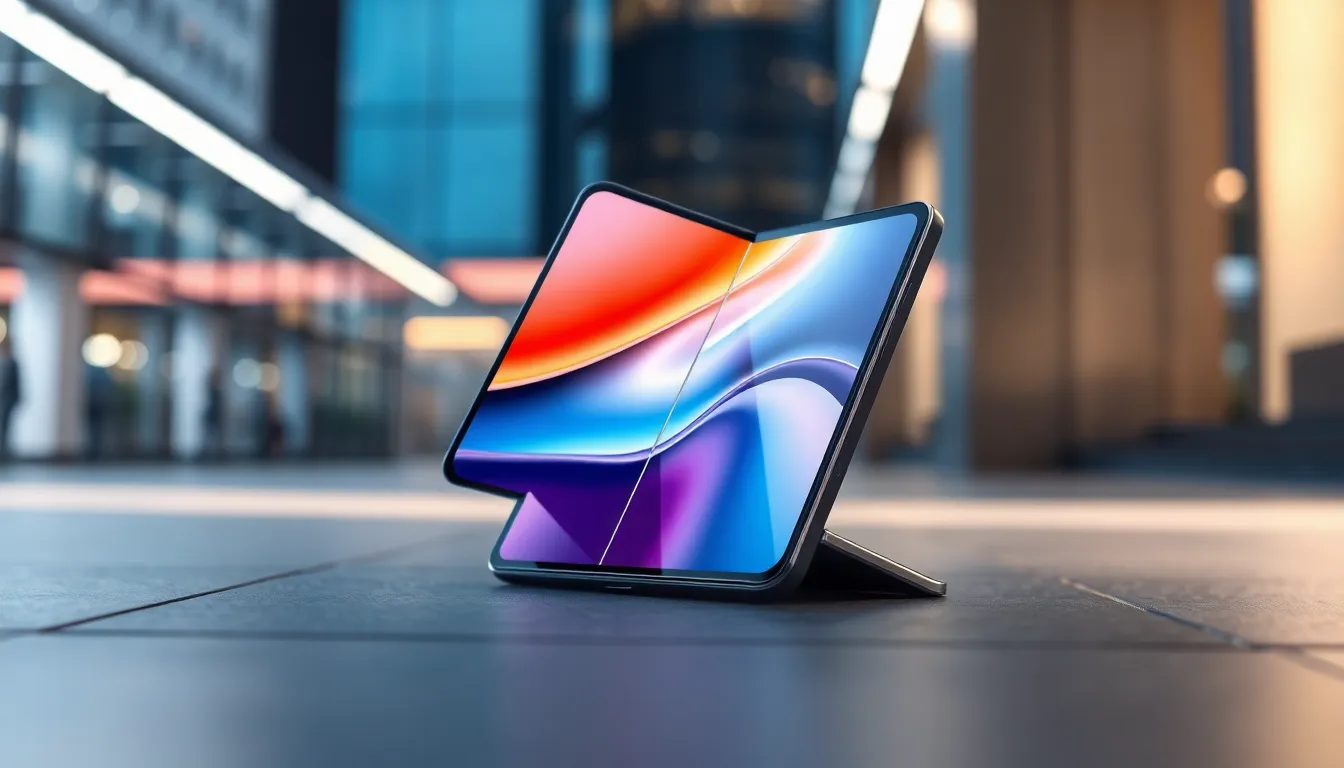In a world where smartphones have become an extension of ourselves, foldable phones are shaking things up with a twist—literally. Imagine a device that fits snugly in your pocket but opens up to reveal a dazzling screen, ready to take on anything from binge-watching your favorite series to multitasking like a pro. It’s like having a tablet and a phone in one, minus the awkward juggling act.
Table of Contents
ToggleOverview of Foldable Phones
Foldable phones represent a significant shift in smartphone technology. These devices merge the convenience of a smartphone with the expansive display often found in tablets.
Definition and Technology Behind Foldable Phones
Foldable phones utilize flexible display technology, allowing screens to bend without damage. OLED panels commonly form the backbone of these displays due to their ability to remain thin and adaptable. Engineers incorporate hinge mechanisms enabling seamless transitions between tablet and phone modes. Various manufacturers employ different designs, such as clamshell or book-style, to cater to user preferences. The technology focuses on durability, ensuring that repeated folding doesn’t lead to wear and tear.
Evolution of Foldable Phones in the Market
The evolution of foldable phones began with prototypes showcased in 2013. Samsung and Huawei emerged as pioneers, launching their first models in 2019. Initial designs faced criticism for durability and screen issues, prompting manufacturers to refine their approaches. As time progressed, more brands entered the market, offering diverse models and price points. By 2023, foldable phones gained traction, boasting improved technologies and greater consumer interest. Features like multitasking capabilities and enhanced battery life significantly contributed to growing adoption rates.
Key Features of Foldable Phones

Foldable phones stand out due to their unique blend of innovative design and enhanced functionality. Their key features empower users to enjoy new experiences.
Display and Design Innovations
Innovative display technology defines foldable phones. OLED panels integrate flexibility, allowing screens to bend without compromising on quality. Various designs exist, including clamshell and book-style formats that cater to diverse preferences. User experience enhances as screens expand from compact phone sizes to larger tablet formats. The seamless transition not only offers larger viewing areas but also facilitates multitasking. Companies continually evolve hinge mechanisms, improving durability and ease of use.
Performance and Hardware Specifications
Robust hardware enhances the performance of foldable phones. Powerful processors enable smooth multitasking and fast app loading. Most devices include high RAM capacities, which support running multiple applications simultaneously without lag. Advanced battery technology ensures that even with larger displays, phones maintain impressive battery life. Users benefit from improved camera systems that deliver high-quality photography in any mode. Overall, foldable phones combine cutting-edge specifications, making them reliable choices for consumers seeking innovation in technology.
Popular Foldable Phone Models
Foldable phones have grown in popularity, showcasing innovative designs from various brands. The following models stand out in the current market.
Samsung Galaxy Z Fold Series
Samsung’s Galaxy Z Fold series exemplifies premium foldable technology. These devices feature expansive screens that unfold to provide tablet-sized displays. The Z Fold 4, for instance, boasts a 7.6-inch Dynamic AMOLED main display, enhancing productivity and entertainment options. Multitasking capabilities enable the use of multiple apps simultaneously, which appeals to power users. Their robust hinge mechanism allows for smooth transitions between phone and tablet modes. Advanced camera systems contribute to excellent photography, ensuring high-quality images whether folded or unfolded.
Motorola Razr
The Motorola Razr marks a stylish return to flip phone designs with modern enhancements. This device combines a nostalgic form factor with cutting-edge technology. The latest Razr model has a 6.2-inch foldable pOLED display, providing immersive visual experiences. Quick access to notifications is made easy through its external display, which adds convenience. Packed with a capable processor and solid camera features, it balances style with performance. The compact design makes it a favorite, especially among users who appreciate unique aesthetics combined with functionality.
Pros and Cons of Foldable Phones
Foldable phones come with distinct advantages and limitations. Understanding these factors helps users make informed decisions.
Advantages of Using Foldable Phones
Flexibility stands out as a primary benefit. Users enjoy the convenience of a compact phone that transforms into a larger tablet, enhancing productivity. Enhanced multitasking capabilities allow users to run multiple apps simultaneously on expansive screens. The improved display quality and vibrant colors of OLED panels elevate the viewing experience, benefiting entertainment activities like streaming and gaming. Compact designs enable easy portability while still offering a spacious interface. Innovative hinge mechanisms also ensure seamless transitions between modes, promoting a user-friendly experience.
Disadvantages and Limitations
Several disadvantages accompany foldable phones. Initial durability concerns remain relevant as these devices face wear and tear with frequent folding. Repairing damaged screens can also prove costly compared to traditional smartphones. Battery life often falls short, given the power demands of larger displays and multitasking features. Limited third-party app support may impact the functionality of certain apps designed specifically for folding screens. Lastly, higher price points can deter potential buyers, as premium features come with a premium cost.
Future of Foldable Phones
Foldable phones are set to transform the smartphone landscape even further. Innovations in design and functionality promise exciting developments.
Predictions for Upcoming Models
Expect brands to introduce lighter and thinner models, utilizing advanced materials for enhanced durability. Companies may also integrate faster processors and improved cameras to meet growing consumer demands. Features like under-display cameras could emerge, delivering a seamless screen experience. Enhanced battery technology should allow for longer usage between charges. Foldable designs will likely expand beyond phones, encompassing wearables and tablets, paving the way for versatile tech ecosystems. As consumers seek multifunctionality, the upcoming models aim to blend portability with enhanced display capabilities.
Potential Market Trends
The foldable smartphone market is poised for significant growth, reaching an estimated market size of $47 billion by 2027. Increased consumer awareness and improved usability will drive adoption rates. Competitive pricing strategies will emerge as more brands enter the foldable arena, making these devices more accessible. Sustainability will likely become a crucial focus, with manufacturers exploring eco-friendly materials and recycling initiatives. Additionally, advancements in 5G technology may play a role, enhancing streaming capabilities and multitasking on foldable devices. As these trends unfold, the demand for foldable phones is expected to rise significantly.
Foldable phones are undeniably shaping the future of mobile technology. With their unique blend of portability and expansive display capabilities, these devices cater to a growing demand for versatility in everyday use. As manufacturers refine their designs and address durability concerns, the appeal of foldable phones continues to rise.
The market is poised for significant growth, driven by innovations in technology and consumer preferences. As foldable devices become more accessible and affordable, they promise to redefine how users interact with their smartphones. The evolution of this technology is just beginning, and it’s clear that foldable phones are here to stay, making them an exciting option for tech enthusiasts and casual users alike.



